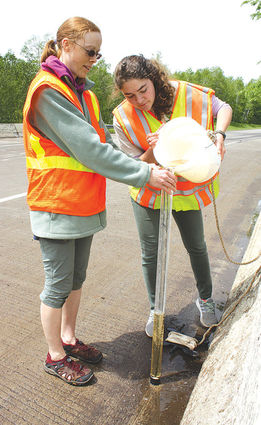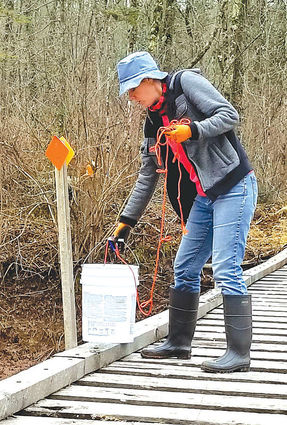Take the plunge into water monitoring!
April 19, 2019

Contributed photos
Carlton SWCD water resource technician Melanie Bomier (left) and her summer assistant Kinzey Stoll fill a Secchi tube with water from the Kettle River during monitoring work in summer 2016.
Well, I did it. I took the plunge! The water's great and I aim to help keep it that way!
No, I didn't literally jump into the water, especially this time of year! Brrrrrr! But after thinking about it for several years, I decided that now was the time to put away "all talk, no action" and jump into being a citizen water monitor (CWM) volunteer.
As with any job, especially volunteer work, you have to learn what to do and how to do it, where to do it, why it needs to be done, and why you should do it. And the best people to learn from are the ones who have been or are currently doing that kind of work.
Q: Why does monitoring work need to be done?
Melanie Bomier, water resource technician at the Carlton Soil and Water Conservation District (SWCD), has done water monitoring for several years through grants received by the SWCD. She has also trained and directed CWMs.
"Citizen monitoring is so important because it helps us understand lake and stream trends," she said. "We usually only have grants to monitor a lake or stream for a couple of years and may not have another opportunity to monitor it again for another 10 years. In the meantime, we might be working on projects to improve water quality or find that major changes are happening in the watershed, but it's hard to know what effect these changes are having without the monitoring data. In addition, for statistical analysis, we need 10 years' worth of data. Citizen monitors fill in those gaps and help us understand if things are getting better or worse over time."
Byron Kuster, a resident on Coffee Lake south of Moose Lake, has been a CWM on that lake for four years. A physics and chemistry teacher, Kuster monitors to see what changes happen with the lake. If all of a sudden there were differences, it would indicate something is going on.
He pointed out that if you don't have any data, then you don't have anything to back up your assumptions.
However, if you have "quantitative, numerical data" and especially "ongoing data," then you have a scientific way to advance knowledge and figure out what may be the problem and how it could be corrected, Kuster said.
Torina Stark is a CWM on the Nemadji River and Rock Creek.
"The Minnesota Pollution Control Agency relies on data from citizen water monitors all over the state to gauge the health of our water systems and determine what needs to be studied further," Stark said.
According to the MPCA, volunteer-collected data is important not only to detect trends in water clarity over time, but also to "formally assess the health of lakes and streams by comparing them to state water quality standards. Lakes and streams that fail to meet water quality standards are categorized as impaired and require restoration to improve their overall health."
For some lakes and streams, volunteer monitoring is the only data available, "making this work indispensable."
Q: What do CWMs do and how do they do it?
For over 40 years, MPCA has recruited and worked with CWM volunteers and they have set up a simple and easy system. CWMs don't need experience or training. MPCA provides the volunteers with everything they need except for the bucket or the boat. Those who monitor lakes will need access to a boat, canoe, or kayak. Those who monitor streams or rivers will do their work from the riverbank or a bridge crossing, usually using a bucket to collect water.
If they are volunteering on a grant project, the CWM may have to take samples of water and deliver them to a location where they will be delivered to a testing site. However, most CWMs are simply asked to conduct water clarity tests once a week (or at least twice a month) from the end of April to the end of September.
Water clarity is determined by finding the disappearance/reappearance point on a Secchi disk as it descends into a lake or in a special stream collection tube, both provided by the MPCA. Volunteers note that appearance point on the chart, again provided by MPCA, and also note other characteristics of the water.
It's a simple process, Stark says about her weekly walk down to the Nemadji River with "a clipboard and pen, my phone/camera, a bucket and a Secchi tube."
After walking across the bridge, she drops a bucket into the water to get a sample.
"I note on my paper what the water level is, how it looks, and if it is suitable for recreation," she explained. "I take a picture of the Nemadji and then bring the water to shore and pour it into the Secchi tube."
According to Kuster, CWM work is not difficult.
"It's minimal effort that has substantial value," he said, adding that "it's an easy commitment that you should try to do as consistently as you can, [but] if you have to leave it for awhile, if some circumstances come up and you can't do it as often as you would like, [then you] just do the best you can. Whatever you can do is appreciated."
Q: Where are CWMS needed?
According to the MPCA website, there are more than 400 CWM volunteers monitoring more than 500 stream sites in Minnesota. Bomier said the website shows there are nine volunteer lake monitors and seven stream monitors in Carlton County.
While Bomier directs people to the Citizen Monitoring program (at MPCA) to enroll, if people have questions, or want to know where monitoring is needed in the county, or want some training, she is more than happy to help them get started.
"Carlton County has a number of water sites that need someone to visit them each week," Stark added. "Even if you don't live near one of these sites, you can always make suggestions. For example, when the Nemadji River flooded last year and became completely inaccessible, I started monitoring Rock Creek which runs through my backyard. This year, I will pull samples from both each week."
Q: Why should you ... or I ... do water monitoring?
Kuster said he continues CWM work because he's measuring the water quality on the lake he lives next to.
"It takes minimal effort to have some basic data on this lake," he said, noting that it helps to have that ongoing data from monitoring. "It would be wonderful if everyone does a little bit, if each lake or river has one person who does monitoring."
"It's an opportunity to get more involved at the local level doing work that contributes to water quality statewide," Stark said, adding that doing her water monitoring takes only a few minutes. "You get so much out of it. I get to watch the animals, butterflies, river. I get to see how the quality of the water changes.
"Plus, it gives me a reason to go to the river every week to see the changes, to watch another amazing year of changes."
Melanie, Byron, Torina, and I, along with hundreds of citizen water monitors around the state, invite you to get out and "take the plunge!" The water in Carlton County is great! And we'd love to have you help us working to keep it that way!
Kim Samuelson is Carlton SWCD's elected supervisor for District 4. For more information about the Citizen Water Monitoring program, contact Melanie Bomier, Carlton SWCD Water Resource Technician, at 218-384-3891. You can also get information from the MPCA website (www.pca.state.mn.us/water/about-programs). For more information about Carlton SWCD, check them out on Facebook or on their website at http://www.carltonswcd.org.


